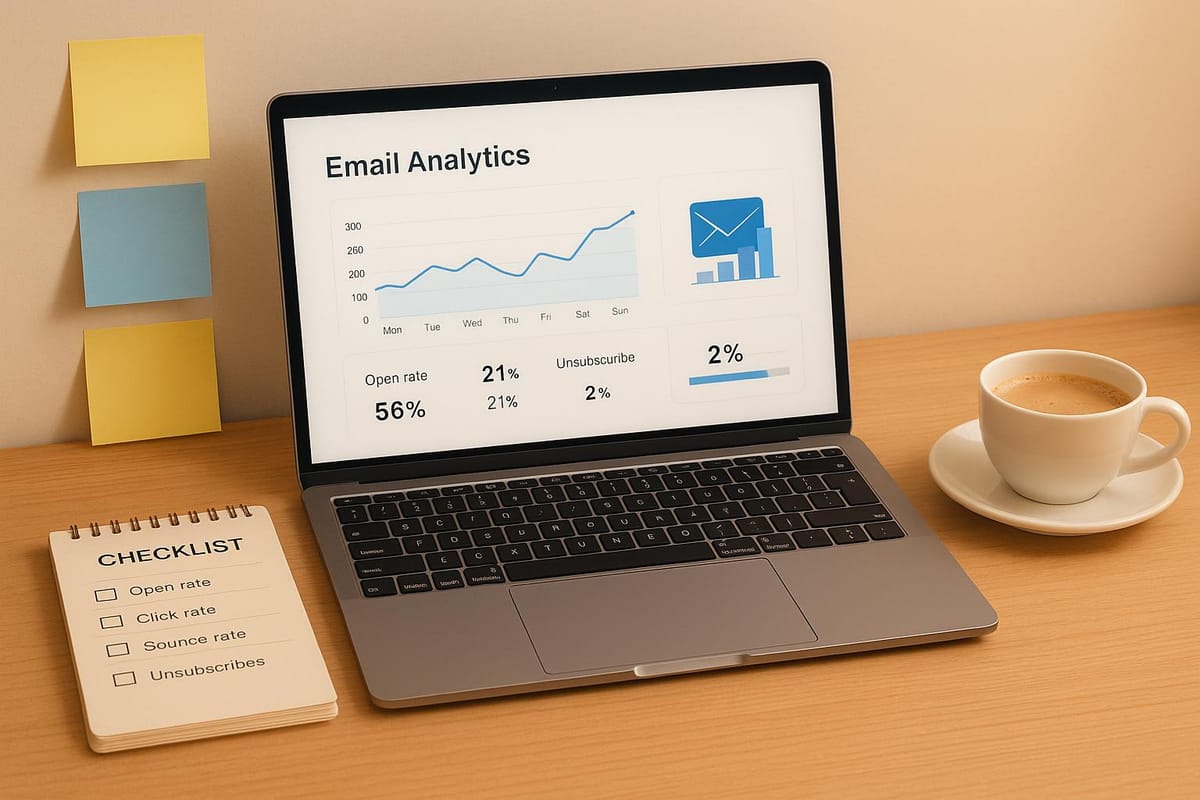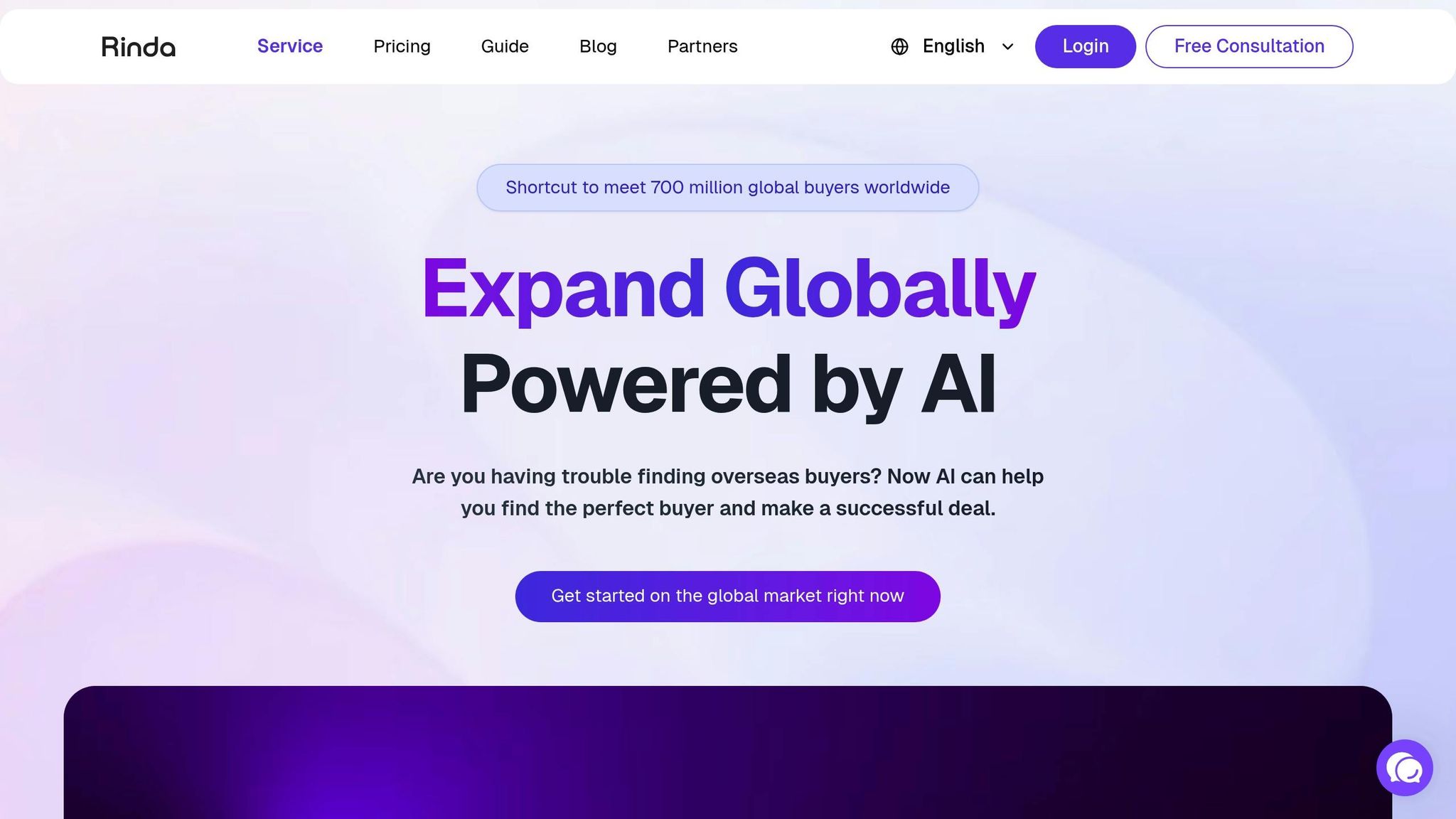Checklist for Monitoring Email Engagement Metrics
Unlock the power of email engagement metrics to boost ROI, refine strategies, and enhance campaign performance with practical insights and best practices.

Email engagement is more than just a marketing buzzword - it’s a measurable driver of ROI. With over 4.5 billion email users in 2024, growing to 4.8 billion by 2027, email remains a key tool for sales teams. Yet, many businesses overlook the deeper insights that engagement metrics provide. According to industry experts, tracking beyond basic open rates is critical for understanding buyer behavior and refining strategies that can deliver up to 3,600% ROI - or $36 for every $1 spent.
In this article, you'll discover:
- How to measure key engagement metrics like open rates, click-through rates, and conversions to improve campaign performance.
- The importance of time-to-engagement data to identify optimal sending times and high-potential leads.
- Practical steps to clean email lists and maintain a strong sender reputation, ensuring higher deliverability.
As businesses face competitive pressures and increasing reliance on digital outreach, understanding these metrics is no longer optional. Whether you’re looking to optimize your campaigns or protect your sender reputation, these strategies will help you stay ahead. Let’s explore how to transform raw data into actionable insights.
What Key Metrics Should I Track On An Email Dashboard? - TheEmailToolbox.com
Key Email Engagement Metrics to Monitor
Tracking the right metrics is critical for understanding how recipients interact with your email campaigns. These insights not only shed light on user behavior but also help refine strategies for better results. Below, we explore key metrics and their significance.
Open Rate and Time to Open
The open rate reflects the percentage of recipients who open your emails, while time-to-open measures how quickly they engage after receiving them. By analyzing time-to-open data, sales teams can better understand audience behavior and fine-tune their sending schedules. For instance, if your open rate is high but recipients take longer to open emails, it might be worth revisiting your subject lines or adjusting your send times. Segmenting your audience can also reveal timing patterns, allowing for more precise scheduling.
Click-Through Rate and Time to Click
Click-through rate (CTR) measures how well your content and calls-to-action (CTAs) motivate recipients to take action, bridging the gap between awareness and conversion. Time-to-click adds another layer of insight, showing how quickly recipients act after opening an email. Quick clicks often indicate that your content is resonating and your CTAs are effective. Use A/B testing to experiment with CTAs, button designs, and layouts. Keep your emails easy to scan with clear, clickable links to improve engagement.
Reply Rate and Conversion Rate
Reply rate serves as a measure of how well your email content encourages meaningful two-way communication, which can signal genuine interest from prospects. Tailored messaging that addresses specific challenges or needs typically results in higher reply rates. Conversion rate, on the other hand, tracks how many recipients complete desired actions, such as scheduling a demo, downloading a resource, or making a purchase. Segmenting these metrics by campaign type or audience group can provide actionable insights to refine your messaging and improve lead quality and sales results.
Bounce Rate and Deliverability
Bounce rate indicates the percentage of emails that fail to reach recipients' inboxes, which can affect your sender reputation. A high bounce rate often points to issues with the quality of your email list. Understanding the difference between hard bounces (permanent failures) and soft bounces (temporary issues) is essential. Regularly cleaning and validating your email list ensures reliable delivery and protects your sender reputation.
Unsubscribe and Spam Complaint Rates
Unsubscribe and spam complaint rates offer valuable feedback on how well your content aligns with audience expectations. While some unsubscribes are inevitable, a high rate may signal problems with targeting, frequency, or content quality. For context, the industry standard for spam complaints is less than 0.02% - or about one complaint per 5,000 recipients. Providers like Google recommend keeping spam complaint rates below 0.1% and never exceeding 0.3%. Rates above 0.2% can harm your sender reputation.
For ecommerce businesses, unsubscribe rates typically hover around 0.27%, with rates up to 1% generally considered acceptable. However, an unsubscribe rate above 1.5% may indicate deeper issues. It's worth noting that recipients are three times more likely to unsubscribe than to mark an email as spam. To maintain audience satisfaction, monitor these metrics closely and ensure a straightforward unsubscribe process is in place. This not only boosts subscriber trust but also helps improve overall campaign performance.
Step-by-Step Checklist for Monitoring Email Metrics
Taking a structured approach to email metrics can transform raw data into actionable insights. By following these steps, you can evaluate overall performance while keeping an eye on critical timing metrics. Start by aligning your email strategy with clearly defined campaign goals.
Set Clear Campaign Goals and KPIs
Start by outlining specific, measurable objectives that align with your broader sales strategy. Research industry benchmarks to set realistic goals for your key performance indicators (KPIs), tailored to your sector and competitive landscape. Focus on metrics like open rates, click-through rates, conversions, and revenue generated to gauge success.
To ensure thorough monitoring, use both primary metrics, which measure your main objectives, and secondary metrics, which help identify potential hurdles in the customer journey. This dual approach allows you to track not only the final outcomes but also the steps leading up to them, offering a clearer picture of your campaign’s overall performance.
Once your goals are set, shift your focus to refining your audience.
Segment Email Lists for Targeted Analysis
Segmentation is the key to turning generic email campaigns into personalized experiences that resonate with specific groups. By dividing your audience into 2–3 segments based on relevant criteria - such as location, purchase history, or engagement levels - you can craft messages that are more likely to engage your readers.
"Email segmentation is the simplest way to ensure you're sending the right message to the right person at the right time. You don't need any technical skills to create segments of your audience, either. Most - if not all - ESPs will give you that feature out-of-the-box. The only thing you need to decide is what segments you want to create"
This approach is particularly effective, as 70% of consumers engage only with personalized messaging. With segmentation in place, you can enhance engagement and improve overall campaign results.
Now, let automation simplify your tracking process.
Automate Metric Tracking and Reporting
Leveraging automation tools for metric tracking and reporting helps reduce errors and ensures timely insights. Choose a reporting tool that integrates seamlessly with your existing platforms, offers scheduling options, and allows for customization.
Set up automated reports to pull data from key sources like Google Analytics, social media channels, and customer relationship management (CRM) systems. This creates a unified view of performance while saving time and boosting accuracy.
"Automating email reports isn't just about saving time; it's about consistently delivering insights that drive action"
Automation can reduce report creation time by up to 95%, giving you more bandwidth to focus on strategy while maintaining accuracy.
After automating, compare your results to industry norms.
Benchmark Performance Against Industry Standards
Comparing your metrics to industry benchmarks provides essential context for evaluating your campaigns. Regularly review your performance against these benchmarks, as well as your historical data, to identify trends or areas for improvement.
Use the benchmarks you established during goal-setting to assess whether your results align with expectations. Keep an eye out for patterns that may point to seasonal trends, changes in audience behavior, or the effects of specific campaign adjustments. By continuously tracking and refining your approach, you can maintain competitive performance and adapt to evolving conditions.
Lastly, don’t overlook the importance of list hygiene.
Update and Clean Email Lists Regularly
Keeping your email list clean is vital for maintaining a strong sender reputation and ensuring accurate metrics. Regularly review and remove inactive contacts - those who haven’t engaged in 6–12 months, for example - and monitor unsubscribe and spam rates to spot potential issues.
Schedule routine list maintenance to ensure your data remains relevant. Before removing inactive subscribers, consider running re-engagement campaigns to give them a chance to confirm their interest. This strategy helps you retain genuinely engaged contacts while filtering out those who no longer find value in your communications.
Tools for Email Engagement Tracking
Choosing the right analytics platform can transform raw email data into insights that truly drive results. With 4.37 billion email users worldwide in 2023 and 69% of consumers favoring email for brand communications, it's clear that tracking tools are no longer optional - they're essential for sales success. The goal is to select platforms that not only track comprehensive metrics but also integrate effortlessly into your current workflows. Let’s dive into the key features that make these platforms indispensable.
Overview of Email Analytics Platforms
Modern email analytics tools go far beyond simply tracking opens and clicks. The best platforms combine real-time response tracking with detailed monitoring, allowing businesses to adjust strategies on the fly. In fact, companies leveraging advanced email analytics report a 43% higher ROI compared to those relying on basic metrics.
When evaluating these tools, focus on features that directly impact your bottom line. Look for platforms that automate the tracking of key metrics like open rates, click-throughs, and conversions. Advanced tools also offer real-time response tracking, helping you identify when and how recipients engage with your emails. A/B testing capabilities are another must-have, enabling you to refine campaigns based on actual data rather than guesswork. Customizable dashboards are particularly valuable, as they allow you to prioritize the metrics that matter most to your business. Seamless integration with CRMs, marketing automation platforms, and other core systems is also critical.
Connor Snell, Social Media & Content Strategist at Altos, shared his experience with one such tool:
"Litmus Email Analytics allowed us to pivot the client's email strategy based on engagement data and create more effective emails. As a result, they saw a 35% increase in open rates".
This example highlights how the right platform can lead to measurable improvements in email performance.
Don’t overlook security and compliance features, especially when dealing with sensitive customer or prospect data. Ensure that any platform you choose adheres to industry standards and offers robust data protection. With these foundational elements in place, platforms like RINDA take email engagement tracking to the next level.
RINDA's Role in Optimizing Email Engagement

RINDA elevates email engagement tracking by combining AI-driven personalization with detailed performance analytics. This dual approach helps create tailored content that resonates with recipients while also providing deep insights into its effectiveness.
Supporting over 20 languages, RINDA empowers global sales teams to monitor engagement and understand regional response trends. Its AI-powered buyer discovery and real-time interest verification ensure that your focus remains on qualified prospects, delivering more meaningful data and boosting conversion rates.
RINDA also automates the analysis of email performance, offering strategic recommendations based on detailed campaign data. By identifying which personalization elements yield the highest engagement, RINDA helps refine your outreach efforts for better results. This cycle of continuous improvement ensures that your email metrics consistently trend upward.
For businesses aiming to expand globally, RINDA’s All-in-One plan offers a comprehensive solution at $798–$1,000 per month. The package includes expert support and a "No meeting, full refund" performance guarantee, reflecting its commitment to delivering tangible engagement improvements.
Best Practices for Improving Engagement Metrics
After analyzing your metrics in detail, the next step is to apply strategies that can elevate your engagement. With 95% of marketers already employing some form of email personalization and 76% of buyers expecting tailored experiences, it's clear that email engagement standards are evolving. To stay ahead, it’s time to go beyond the basics and craft campaigns that resonate deeply with your audience.
Personalization and Content Optimization
Personalization isn’t just about adding a recipient’s name to an email. For example, emails with personalized subject lines see a 26% higher open rate, and marketers report a 20% average boost in sales when they deliver tailored experiences. The most effective campaigns leverage a blend of data sources - zero-party data from surveys, first-party data like browsing history, and carefully chosen second-party partnerships - to create highly relevant content.
Real-world examples demonstrate the power of advanced personalization. Adidas dynamically adjusts promoted products based on the recipient's gender, ensuring that each email feels relevant. Similarly, Sephora uses marketing automation to reward VIP customers with special offers once they hit specific spending milestones.
Despite its potential, only 3% of marketers currently use live or real-time dynamic content. This presents a major opportunity. Incorporating elements like real-time inventory updates, location-specific offers, or personalized pricing can significantly increase engagement.
Adding a human element also enhances connection. Use real names in the "from" field instead of generic company addresses, and consider showcasing photos of team members instead of a corporate logo. For instance, Dubsat personalizes their emails by using the name of the client’s account manager in the "from" field, creating a sense of familiarity.
Beyond personalization, timing and design play a crucial role in ensuring your content lands effectively.
Timing and Responsive Design
Strategic timing can dramatically improve email engagement. Research shows that targeted personalization boosts engagement for 74% of marketers. By analyzing subscriber behavior, you can pinpoint the best times and frequencies for sending emails. Since most emails are now opened on mobile devices, it’s essential to design messages that are responsive and load quickly across all platforms. Testing across devices and email clients ensures a seamless experience for every recipient.
Understanding time-to-engagement data is equally important. By tracking when recipients open and interact with your emails, you can schedule future campaigns to align with peak engagement times, maximizing the visibility and impact of your content.
With timing and design optimized, the next step is to continuously refine your campaigns based on performance insights.
Monitor and Adjust Campaigns
Ongoing monitoring and a willingness to act on performance data are critical for sustained success. Aim for delivery rates above 95% and unsubscribe rates around 0.2%. If these benchmarks fall, immediate action is necessary to protect your sender reputation.
Desirae Odjick, Product Marketer at Shopify, emphasizes the importance of recipient interaction:
"Email deliverability depends on how recipients interact - opening, clicking, or marking as spam".
A/B testing is an invaluable tool for finding what works best with your audience. Experiment with subject lines, send times, content formats, and call-to-action placements to identify the most effective combinations. Additionally, segmenting your email lists allows you to deliver content that’s more relevant to specific groups, boosting engagement even further.
Addressing poor metrics quickly is essential. High bounce rates may indicate outdated or invalid email addresses, which can be resolved through list cleaning and validation. Rising unsubscribe rates often point to content that doesn’t align with audience expectations or overly frequent emails. Spam complaints require a careful review of your content strategy and sending practices. Ensuring that unsubscribe links are easy to find can also help reduce these complaints.
Regularly maintaining your email lists and refining segmentation ensures your campaigns reach genuinely interested recipients. This not only protects your sender reputation but also maximizes the return on your email marketing efforts.
FAQs
What’s the best time to send emails to boost engagement?
The most effective times to send emails for better engagement generally fall on weekday afternoons, particularly between 3:00 PM and 7:00 PM, with peak performance often occurring from 4:00 PM to 6:00 PM. For weekends, mornings around 9:00 AM tend to yield strong results. Another high-performing window is Tuesday mornings between 10:00 AM and 1:00 PM.
These periods align with moments when people are more likely to check their emails - during lunch breaks or after completing significant tasks. However, the key to success lies in testing and analyzing your audience's specific habits to pinpoint the timing that works best for your campaigns.
How can I clean and manage my email list to improve deliverability?
To ensure your emails consistently land in inboxes rather than spam folders, maintaining a clean and well-managed email list is key. Begin by removing invalid or bounced email addresses - this reduces bounce rates and strengthens your sender reputation. Additionally, segment your list to prioritize subscribers who actively engage with your content. For those who haven’t interacted in a while, consider running re-engagement campaigns. These campaigns give inactive users the chance to confirm their interest or opt out, keeping your list focused and relevant.
Incorporate email verification tools to validate addresses and ensure compliance with spam regulations. Regularly review and update your contacts to keep your list fresh and accurate. These practices not only protect your sender reputation but also improve the likelihood of your emails reaching the intended audience.
How does personalized email content improve engagement and boost ROI?
Personalized email content is a game-changer when it comes to boosting engagement and delivering a stronger return on investment (ROI). Crafting messages that align with individual preferences leads to higher open and click-through rates. In fact, research indicates that personalized emails achieve an average open rate of 29% and are favored by 72% of consumers.
This heightened engagement fosters stronger customer loyalty and contributes to revenue growth. Considering that email marketing typically generates an average return of $42 for every $1 spent, personalization ensures your campaigns resonate more effectively with your audience, making every dollar count.
Related posts
- Global B2B sales trends for 2025 at a glance
- From 95% Out-of-Market to Pipeline Gold: How Real-Time Buyer Intent Data Transforms B2B Lead Discovery
- Email Marketing's AI Revolution: 87% Adoption Rate Delivers 4+ Hours Weekly Time Savings and 60% Cost Reduction
- How AI Alerts Boost Sales Performance Tracking
